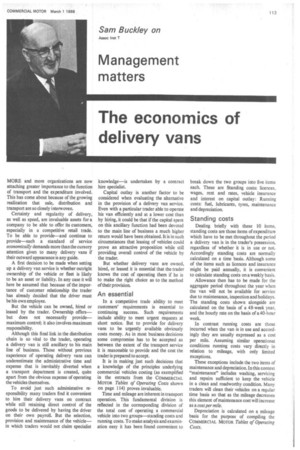Management matters
Page 115

If you've noticed an error in this article please click here to report it so we can fix it.
The economics of delivery vans
MORE and more organizations are now attaching greater importance to the function of transport and the expenditure involved. This has come about because of the growing realization that sale, distribution and transport are so closely interwoven.
Certainty and regularity of delivery, as well as speed, are invaluable assets for a company to be able to offer its customers, especially in a competitive retail trade. To be able to provide—and continue to provide—such a standard of service economically demands more than the cursory attention given to many delivery vans if their outward appearance is any guide.
A first decision to be made when setting up a delivery van service is whether outright ownership of the vehicle or fleet is likely to be an asset or liability. In any case it will here be assumed that because of the importance of customer relationship the trader has already decided that the driver must be his own employee.
But the vehicle can be owned, hired or leased by the trader. Ownership offers— but does not necessarily provide— maximum control; it also involves maximum responsibility.
Although this final link in the distribution chain is so vital to the trader, operating a delivery van is still ancillary to his main line of business. Those without previous experience of operating delivery vans can underestimate the administrative time and expense that is inevitably diverted when a transport department is created, quite apart from the obvious expense of operating the vehicles themselves.
To avoid just such administative responsibility many traders find it convenient to hire their delivery vans on contract while still retaining direct control of the goods to be delivered by having the driver on their own payroll. But the selection, provision and maintenance of the vehicle— in which traders would not claim specialist knowledge—is undertaken by a contract hire specialist.
Capital outlay is another factor to be considered when evaluating the alternative in the provision of a delivery van service. Even with a particular trader able to operate his van efficiently and at a lower cost than by hiring, it could be that if the capital spent on this ancillary function had been devoted to the main line of business a much higher return would have been obtained. It is in such circumstances that leasing of vehicles could prove an attractive proposition while still providing overall control of the vehicle by the trader.
But whether delivery vans are owned, hired, or leased it is essential that the trader knows the cost of operating them if he is to make the right choice as to the method of their provision.
An essential
In a competitive trade ability to meet customers' requirements is essential to continuing success. Such requirements include ability to meet urgent requests at short notice. But to provide for delivery vans to be urgently available obviously costs money. As in most business decisions some compromise has to be accepted as between the extent of the transport service it is reasonable to provide and the cost the trader is prepared to accept.
It is in making just such decisions that a knowledge of the principles underlying commercial vehicles costing (as exemplified in the extracts from the COMMERCIAL MOTOR Tables of Operating Costs shown on page 114) proves invaluable.
Time and mileage are inherent in transport operation. This fundamental division is reflected in the corresponding division of the total cost of operating a commercial vehicle into two groups—standing costs and running costs. To make analysis and examination easy it has been found convenient to break down the two groups into five items each. These are Standing costs: licences, wages, rent and rates, vehicle insurance and interest on capital outlay: Running costs: fuel, lubricants, tyres, maintenance and depreciation.
Standing costs
Dealing briefly with these 10 items, standing costs are those items of expenditure which have to be met throughout the period a delivery van is in the trader's possession, regardless of whether it is in use or not. Accordingly standing costs are normally calculated on a time basis. Although some of the items such as licences and insurance might be paid annually, it is convenient to calculate standing costs on a weekly basis.
Allowance then has to be made for the aggregate period throughout the year when the van will not be available for service due to maintenance, inspection and holidays. The standing costs shown alongside are calculated on the basis of a 48-week year, and the hourly rate on the basis of a 40-hour week.
In contrast running costs are those incurred when the van is in use and accordingly they are usually expressed as a cost per mile. Assuming similar operational conditions running costs vary directly in relation to mileage, with only limited exceptions.
These exceptions include the two items of maintenance and depreciation. In this context "maintenance" includes washing, servicing and repairs sufficient to keep the vehicle in a clean and roadworthy condition. Many traders will clean their vehicles on a regular time basis so that as the mileage decreases this element of maintenance cost will increase as a cost per mile.
Depreciation is calculated on a mileage basis for the purpose of compiling the COMMERCIAL MOTOR Tables of Operating Costs.








































































































































































